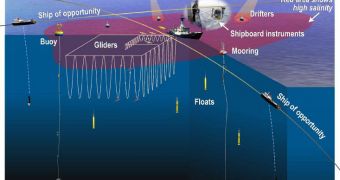Scientists at the American space agency have devised a cunning plan to obtain a 3D view of salinity levels in the world's ocean. The idea came from the SAC-D satellite and its Aquarius instrument.
The spacecraft, which will launch this week, carries a NASA instrument called Aquarius, which is capable of analyzing the first centimeter (0.4 inch) of the ocean surface. The device can produce weekly and monthly salinity maps, showing how this feature changes.
But researchers have been aware of Aquarius' limitations ever since they designed and built the instrument. They knew, for example, that it will not be able to penetrate deep under the surface.
This is why they are now planning to augment the satellite's capabilities via instruments on the ground, as it were. Some of these include research ships, commercial cargo ships, floating instruments, buoys, free-drifting platforms, underwater gliders and an autonomous underwater vehicle (AUV).
All these capabilities will work side-by-side with Aquarius to produce the 3D view of ocean salinity experts want to obtain. This little-researched aspect of the oceans has a tremendous impact on the world's climate, even if salt makes up only a small portion of the waters.
However, the chemical affects the way water is circulated by currents, how much of it evaporates and so on. In turn, these factors influence climate over entire continents, regulating precipitation patterns, droughts, floods and sea level rise or fall.
“The next question is: How do you understand what the satellite sees? Without deploying instruments under the ocean's surface, we do not know how to fully interpret the satellite observations of surface salinity,” Yi Chao says.
The expert, who is based at the NASA Jet Propulsion Laboratory (JPL), in Pasadena, California, is the principal scientist of the Aquarius project. The new NASA field experiment is called SPURS, which stands for Salinity Processes in the Upper Ocean Regional Study.
The ultimate goal of the work is to understand how the planet's water cycle functions. Ocean salinity apparently bears a considerable influence on this aspect, one that has been largely neglected by the international scientific community until now.
“One of the big questions is how much will the water cycle accelerate because of warming?” Woods Hole Oceanographic Institution (WHOI) oceanographer and SPURS project scientist Raymond Schmitt explains.
“We're seeing big changes in ocean salinities that can only be explained by an increase in the water cycle. We see this changing salinity, and we want to relate it to the changing water cycle – but we have to understand what the ocean is doing,” he concludes.

 14 DAY TRIAL //
14 DAY TRIAL //